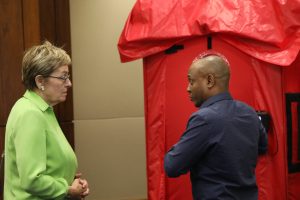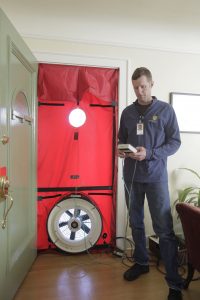
The blower door is synonymous with the Weatherization Assistance Program (WAP). It’s a test that is performed on every home before and after work is completed to assess the effectiveness of weatherization, a critical tool for ensuring we maximize energy savings and a reliable safeguard on the use of public funds.
The blower door test measures air leakage, which aids in analyzing home performance and developing a customized work plan addressing energy efficiency needs. This customized approach to whole-house retrofits is very important because each home is unique and requires a slightly different scope of work. Weatherization not only addresses energy issues, but also helps to improve the health and safety of the household. Additionally, the measurements gathered from the blower door test are used to determine the amount of mechanical ventilation needed in the home, based on the ASHRAE 62.2 standard. The Coronavirus pandemic has taught us a lesson that has long been embraced by the WAP: properly designed ventilation assists in improving the air quality in buildings. Using the blower door and ASHRAE standard together is now more important than ever.
COVID-19 has prompted some to voice concern about operating a blower door. This concern is understandable given how little is known about the lifecycle of COVID-19 and the lack of scientific evidence related to how air movement during blower door operation may or may not transmit the virus. These concerns, and recommendations from OSHA and DOE to develop disease response plans, have prompted Weatherization providers to implement additional safety protocols that will protect workers and our clients while weatherization work is being performed inside the home.
NASCSP is continually updating our COVID-19 resources including considerations for worker and client safety. This information was gathered from federal agencies such as the CDC and OSHA, and from WAP service providers that are transitioning back to field work after pausing production due to COVID-19. A few important safety considerations are highlighted below, and the full document is available here.
- Assess Risk: Before entering the home, screen workers and clients for COVID symptoms. Sample questions are available here and CAPLAW addresses legal considerations for screening here. Mandate that sick employees stay home and defer service to households with members that are experiencing any symptoms or have reported a positive case of COVID-19.
- Implement Basic Prevention Measures: According to the CDC, COVID-19 spreads mainly through close contact from person-to-person and limiting face-to-face contact is the best way to reduce the spread of coronavirus disease. Prohibit handshaking, maintain physical distance, frequently disinfect equipment, tools and surfaces, and wash hands.
- Implement Engineering and Administrative Controls: Isolate clients from workers when possible. If feasible, consider asking clients to step outside the home while work is being performed, or use engineering controls such as plastic sheeting to minimize the risk of spreading illness from person-to-person. Consider changing administrative procedures to limit person-to-person interactions and increase cleaning and disinfecting.
- Wear PPE: Follow existing OSHA and DOE guidance for worker safety. Consider providing face masks to clients. Require workers wear PPE at all times when inside the home. If everyone inside the home wears face coverings, the risk of transmission is reduced. Remember face coverings are not a replacement for physical distancing.

With enhanced protocols in place, WAP implementers are minimizing risk and enhancing safety. States can also tailor these safety protocols to allow for continued operation of a blower door. Procedures that states may consider requiring include:
- Ensure household members and employees are screened for COVID symptoms before entering home
- Require clients and workers wear face coverings
- Remove all workers from the home that are not necessary for the blower door process
- Consider asking clients if they would wait outside the home and away from the fan while the test is being performed, or request they move to an area of the home away from the flow of air through the fan
- Stand at a distance away from the fan, out of the direct air path, and use wireless technology for operation if available
- Disinfect the blower door after each use
For additional information on blower door operation see the Building Performance Association position statement and the ASHRAE FAQs.
While Coronavirus has had an unprecedented impact on our communities and the WAP, addressing safety concerns is nothing new to WAP providers. Our highly trained and certified technicians encounter hazards on the job every day whether it is testing lead paint, addressing possible asbestos containing material, or evaluating severe cases of mold and moisture. WAP providers are updating their protocols and workplace safety practices accordingly to assess and mitigate the risk of Coronavirus transmission. Thanks to WAP’s ability to address these health and safety issues utilizing state of the art diagnostic tools such as the blower door, many low-income households receive assistance to improve the quality of their homes and lives.
If you have questions about the information presented here, contact NASCSP WAP Director Amy Klusmeier.





